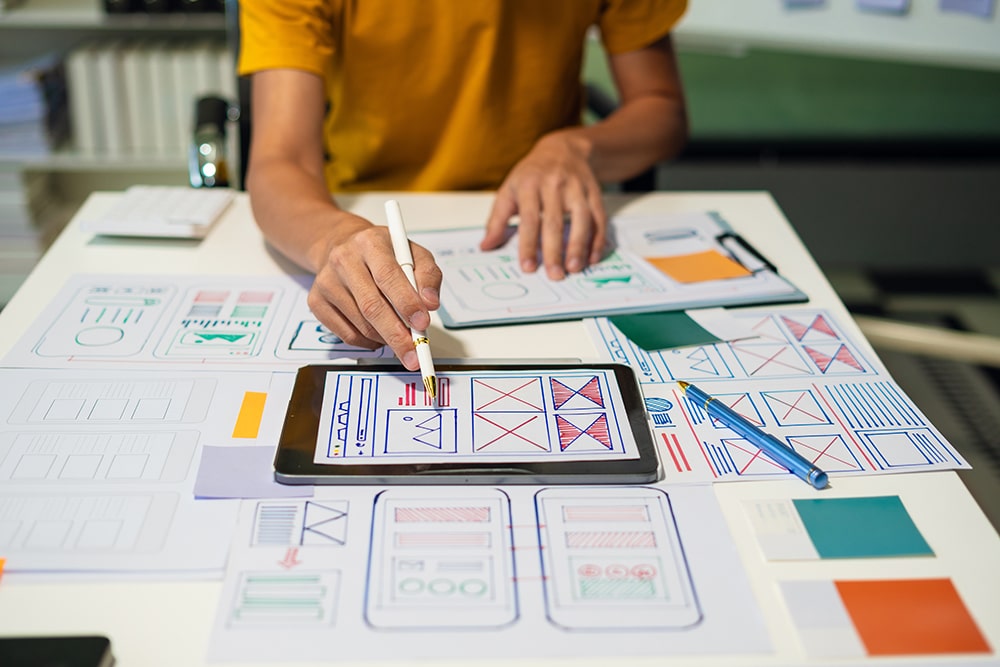Web design is a process of creating visually appealing and functional websites that provide a great user experience. In today’s digital age, a well-designed website is crucial for businesses, organizations, and individuals looking to establish an online presence. Unlike web development, which focuses on coding and technical aspects, web design emphasizes aesthetics, usability, and the overall user experience. Web design focuses on the layout, appearance, and usability of a website, ensuring that users can easily access information, navigate through pages, and complete tasks seamlessly.
The Evolution of Web Design
Web design has evolved significantly over the years. Early websites were often text-heavy, using simple HTML for layout and design. As the internet evolved, so did design trends and technologies. Today, web design is highly sophisticated, incorporating advanced animations, interactions, responsive designs, and a strong focus on user experience. The rise of mobile devices has also driven designers to focus on creating mobile-first designs, ensuring that websites work well on all platforms.
Key Principles of Web Design
User Experience (UX): Good web design prioritizes the user. Every element, from layout to content, should be crafted with the user in mind. A positive UX means visitors find what they’re looking for quickly and easily, leading to longer visits and higher engagement.
Visual Hierarchy: Visual hierarchy guides users’ attention to the most important content first. This can be achieved using size, color, contrast, and spacing. For example, headlines are often larger and bolder to draw attention.
Typography and Readability: Choosing the right fonts is crucial for readability. Opt for fonts that are easy to read across devices and sizes. Limit the use of fonts to two or three to maintain a clean and professional look.
Color Theory: Colors evoke emotions and can influence how users perceive a brand. Understand the psychology of colors and use them strategically to enhance the mood and brand identity of your website.
Consistency: Consistency in design elements like buttons, fonts, colors, and spacing helps create a cohesive and professional look. It ensures users have a seamless experience as they navigate through the website.
Responsive Design
With users accessing websites on various devices, from smartphones to desktops, responsive design has become essential. Responsive design ensures that a website looks good and functions well on all screen sizes. Techniques like media queries, flexible grids, and scalable images allow web designers to create adaptable layouts that enhance the user experience, regardless of the device used.
Fundamental Design Tools and Technologies
HTML and CSS Basics: HTML (Hypertext Markup Language) and CSS (Cascading Style Sheets) are the building blocks of web design. HTML provides the structure, while CSS controls the style and layout. A strong foundation in these technologies is essential for any web designer.
Design Tools: Tools like Adobe XD, Figma, and Sketch are invaluable for creating wireframes, mockups, and prototypes. These tools allow designers to visualize their ideas and collaborate with developers and stakeholders.
CSS Frameworks: Frameworks like Bootstrap and Tailwind CSS help designers quickly build responsive and aesthetically pleasing sites without starting from scratch. They provide pre-built components and styles, saving time and effort.
Accessibility in Web Design
Accessibility ensures that all users, including those with disabilities, can access and navigate your website. This includes using alt text for images, creating keyboard-friendly navigation, and ensuring sufficient color contrast. Accessibility is not just a best practice; it is a legal requirement in many countries.
Performance Optimization
A fast-loading website is crucial for user retention and search engine ranking. Performance optimization involves reducing the size of images, using lazy loading to delay the loading of off-screen content, and minimizing the number of HTTP requests by combining files and using browser caching.
SEO Fundamentals
Search Engine Optimization (SEO) helps your website rank higher in search engine results, making it more visible to potential users. Basic SEO practices include optimizing meta tags, using proper heading structures, and ensuring your site is mobile-friendly. Remember, good web design is closely tied to SEO; a well-structured and easily navigable website is more likely to rank higher.
Testing and Iteration
Testing is crucial to ensure that a website works correctly on different browsers and devices. Tools like BrowserStack or Google’s Mobile-Friendly Test can help identify compatibility issues. Collecting user feedback is also essential for finding pain points and opportunities for improvement. Remember, design is an iterative process – continual refinement leads to a better user experience.
Current Trends in Web Design (2024)
Staying updated with design trends keeps your website relevant and engaging. Current trends include:
Minimalism: Focus on simplicity and clarity.
Dark Mode: Provides an alternative color scheme that reduces eye strain and saves battery life on devices.
Micro-interactions: Small animations or changes that provide feedback to the user, enhancing the interactivity of a website.
Web design is a broad and dynamic field that encompasses various principles, tools, and best practices. By understanding these foundational concepts, you can create effective, user-friendly websites that stand out in today’s competitive digital landscape.
For further learning, my recommendation is to check resources like the “Don’t Make Me Think” book by Steve Krug!







